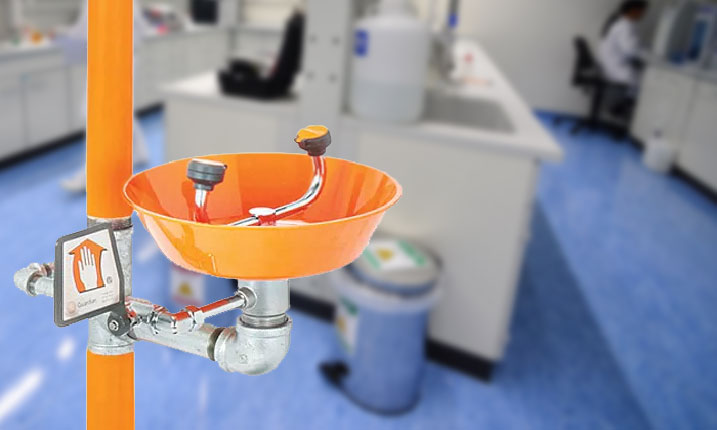Activating a single eyewash station doesn’t take long, but at a sprawling research facility with as many as 2,000 units dotting its campus, activating and testing them all can be a major undertaking. Lab personnel may be relieved to know OSHA simply requires eyewash units and safety showers to be tested “on a regular basis” and does not specify frequency (29 CFR 1910.1450 Appendix A).
But it would be a mistake to stop there. OSHA references ANSI standard Z358.1-2014, which states: “Plumbed eyewashes shall be activated weekly for a period long enough to verify operation and ensure that flushing fluid is available.” ANSI also calls for eyewash units to be fully inspected annually to ensure conformance with the entire standard.
True, ANSI Z358.1 has not been adopted by OSHA, which means it does not carry the full force of law. For background, ANSI, which stands for American National Standards Institute, is a non-profit organization that publishes a set of voluntary consensus standards, not mandates. ANSI does not perform inspections, and they will never issue a fine or citation. However, this does not mean that ANSI standards are soft, toothless suggestions, either.

Desi Arnaz in "I Love Lucy"
If failure to comply with an ANSI standard results in a serious injury, the injured person’s legal team will naturally ask why such a well-known and widely accepted best practice was not being practiced. For this reason, the standards published by ANSI and similar organizations are often called “Ricky Ricardo documents” in the Laboratory Safety Institute’s courses. These are the documents the injured person’s attorney will hold up to the judge or jury, howling that the offending institution has some serious “splainin’ to do.” (For the trivia buffs: there is some controversy over whether Desi Arnaz ever uttered those words on “I Love Lucy,” but that’s for another day.)
In other words, being in perfect compliance with OSHA may avoid a fine, but not complying with ANSI standards will seriously weaken your case in the event of a lawsuit. To prevent and minimize injury, the important thing is to make sure the eyewash works when you need it to, and the only way to be 100% sure is to activate it frequently — weekly if possible. For good measure, it wouldn’t hurt to give the lever a quick bump whenever you walk by. Involve everyone in the safety program by assigning weekly activation to different persons who use the lab.
Also, it’s important to remember that weekly activation isn’t just a matter of confirming that the faucet works. Stagnant water in pipes can be a breeding ground for acanthamoeba and other microbes that can cause serious eye infections, potentially turning your safety device into a safety hazard. Depending on the size of your pipes and any “dead legs” in your plumbing system, you may need to run the water for three minutes or more to flush all the bugs out. The paper, “Quantitation of free-living amoebae and bacterial populations in eyewash stations relative to flushing frequency” presents “eye-opening” research on the subject. (Sorry, I couldn’t resist.)
Where's the Drain?
In some labs, weekly eyewash testing means multiple sloshy trips down the hall with a bucket because incredibly, the lab was built without a drain under the eyewash.
Why on earth, you ask, would someone install a faucet with no place for the water to go? The usual reason is cost — plumbing a new drain is expensive, especially as a retrofit. Sometimes labs don’t install drains due to an often-repeated myth that a tiny amount of hazardous material going down the drain from someone using the eyewash or safety shower is a violation of the Clean Water Act. Actually, the Environmental Protection Agency specifically exempts "discharges from safety showers and rinsing and cleaning of personal safety equipment” (40 CFR 261.3 (a) (2) (iv) (D)).
The costs and risks to human health and environment presented by flooding the entire lab floor (and possibly the floors below) due to not having a drain are likely to be much greater than that of allowing a small amount of super-diluted rinsate into the municipal sewer. Worse, having no drain can make some people hesitate to use eyewashes and showers in an emergency because they “don’t want to make a mess.”
Unless organizational policies or local wastewater regulations say otherwise, having a drain could save a lot of time and money, both now and in the future. However, if you’re stuck in a lab with no drain, Green Gobbler Safety makes some products that can simplify the chore of testing. Their T-Bowl for Eyewash Testing is available from the LSI Shop.

